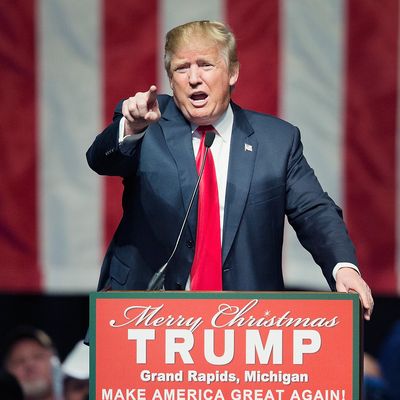
When you consider that the rise and shockingly persistent presence of Donald Trump as a Republican presidential candidate was one of the two or three most important political news stories of 2015, it’s amazing how long it’s taking to get a firm grip on the kind of people who have lifted him to the top of so many polls. Polls that did not examine the educational levels of respondents managed to miss Trump’s special appeal to the non-college-educated (a.k.a. white working class), and led to persistent claims that he’s the candidate of “moderates.” Other polls have excluded significant numbers of Trump fans from their samples because those people have not regularly participated in Republican primaries and caucuses in the past. Putative Trump voters have been compared to the Wallace voters of the 1960s and 1970s and the Perot voters of 1992. A clear fix on them is elusive.
But today the New York Times’ estimable analyst Nate Cohn offers a new profile of Trump supporters based on data supplied by Civis Analytics, a Democratic firm that has conducted a large number of interviews with self-identified Republicans and Republican-leaners during the period of Trump’s ascendancy.
To understand what Cohn has found, however, you have to look past the headline I suspect editors imposed on him: “Donald Trump’s Strongest Supporter: A Certain Kind of Democrat.” In the second paragraph, Cohn does indeed report: “His very best voters are self-identified Republicans who nonetheless are registered as Democrats.” But you have to read far, far down into the piece to understand the limited meaning of that startling data point:
Registered Democrats make up just 8 percent of self-identified Republicans in the states with party registration, according to the Civis data. And Mr. Trump still leads, and leads comfortably, among higher-turnout voters and registered Republicans.
So the headline is based on a triple-loaded statistic: Exclude states with no party registration (e.g., much of the South), and focus only on the small minority of self-identified Republicans who are registered as Democrats, and Trump does better (43 percent) than he does among self-identified Republicans who are registered Republican (again, only in states with party registration), who give him 29 percent of his support. The natural inference from the headline — that Trump supporters are typically Democrats — is neither asserted by Cohn nor supported by the Civis data.
Now that we’ve gotten that out of the way, what do we actually learn about Trump supporters? Cohn says they are “less affluent” and “less educated,” which we already knew; this is almost certainly why they have not internalized the economic policy views of GOP elites. The first thing of considerable interest Cohn adds is that they tend to be concentrated in the South and middle Atlantic states, in contrast to Perot voters, who were most numerous in New England and the West.
He fares best in a broad swath of the country stretching from the Gulf Coast, up the spine of the Appalachian Mountains, to upstate New York.
Mr. Trump’s best state is West Virginia, followed by New York. Eight of Mr. Trump’s 10 best congressional districts are in New York, including several on Long Island. North Carolina, Alabama, Mississippi, Tennessee, Louisiana and South Carolina follow.
His strength in the Empire State could just reflect Trump’s decades of prominence in metropolitan New York. But it makes it harder to compare his following to the long-ago Wallace supporters, though Cohn does gingerly mention the significant overlap between Trump’s strongest areas and those locales reporting the most Google searches of racially charged subjects.
Perhaps the most important finding Civis and Cohn make is one we’ve vaguely known about for a while but can now talk about with greater precision: Trump’s supporters are what is known as “irregular voters.”
Another turnout challenge for Mr. Trump is that he commands the support of many people who are unlikely to vote. Civis found him winning 40 percent of the vote among those it gave less than a 20 percent chance of participating in the general election — let alone in the primary. He held 29 percent among those who had greater than an 80 percent chance of voting in the November election.
Again, you have to note that Trump’s doing better than any other Republican candidate in every category of likelihood to turnout. But his exact percentages, which will matter even more as the field is “winnowed” and movement conservative and/or “Establishment” Republican votes are consolidated, could depend on turning out supporters who don’t routinely vote. And yes, he will lose some votes in “closed primary” states where registered Democrats and independents cannot participate in GOP primaries (the first of these on the calendar is Florida, a winner-take-all state that offers Trump the tempting prospect of a deadly blow against both Rubio and Bush).
So you have the puzzle of a Trump campaign attracting very angry people who also are relatively ill-inclined to vote. Will their anger drive them to the polls? And is Team Trump doing enough to drag them there if they’d rather be doing something else with their time on a given Tuesday?
The first test will obviously be on a Monday night in Iowa a few weeks from now. If total caucus turnout is up sharply and Trump wins or finishes a strong second in the constrained environment of voters having to spend an hour or so (depending on how many candidate representatives make speeches) at a local precinct on a wintry evening, then perhaps we should stop wondering if his “people” will show up in New Hampshire or other states where participation is more convenient. But even then, it’s unclear what happens to them next November if the Donald is not the nominee and keeps his pledge not to run as an independent. Keeping them aboard the GOP train while trying to attract enough Obama coalition voters to gain a majority could be quite the juggling act.






























